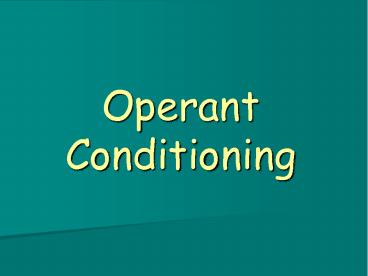Operant Conditioning - PowerPoint PPT Presentation
Title:
Operant Conditioning
Description:
Operant Conditioning I. Operant Conditioning A type of learning that occurs when we receive rewards or punishments for our behavior Behaviors will increase if the ... – PowerPoint PPT presentation
Number of Views:269
Avg rating:3.0/5.0
Title: Operant Conditioning
1
Operant Conditioning
2
I. Operant Conditioning
- A type of learning that occurs when we receive
rewards or punishments for our behavior - Behaviors will increase if the consequences are
reinforced - Behaviors will decrease if the consequences are
not reinforced
3
CLASSICAL VS OPERANT
- CLASSICAL CONDITIONING
- 1 There is always a specific stimulus (UCS) that
elicits a desired response (INVOLUNTARY) - 2. (UCS) does not depend on the learners response
- 3. The learner responds to the environment
- 4. Generalization can occur when the same
response occurs to a similar stimuli
- OPERANT CONDITIONING
- is a process by which the consequences of a
response affect the likelihood that the response
will occur again. - The response is voluntary
- The subject plays a role in what happens
- Generalization can occur in that the individual
MAY learn to generalize the response
4
In Class Activity
- 1. CREATE A VISUAL(ANY KIND)
- - Handout, power point slide
- 2. PRESENT THE VISUAL
- 3. DESIGN, CREATE IMPLEMENT AN ACTIVITY
THAT REINFORCES THE INFORMATION YOU ARE
PRESENTING
5
A. Edward Thorndike The Puzzle Box
6
B. B.F. Skinner (1904-1990)
- Founder of operant conditioning
- Devised ways to test his theories in the real
world - (The Skinner Box)
7
Components of Operant Conditioning
- Reinforcement - Any consequence that increases
the likelihood of a response (behavior) will be
repeated. - a. Positive Reinforcement
- Will strengthen behaviors because the subject
receives something they want
8
Positive Reinforcement
9
b. Negative Reinforcement
- Also strengthens the behavior, because something
the subject doesnt like is removed - Ex If you get all As, you wont have to mow
the yard this summer. - Extrinsic rewards????
10
Negative Reinforcement
11
Positive/Negative Reinforcement
12
2. Primary vs. Secondary Reinforcers
- Primary Reinforcement
- Something that is naturally reinforcing
- Ex food, warmth, water, etc.
- Secondary Reinforcement
- Something that a person has learned to value
often paired with a primary reinforcer - Ex Kind words
13
(No Transcript)
14
(No Transcript)
15
Schedules of Reinforcement
16
Immediate vs. Delayed Reinforcement
- 1. Immediate given immediately after the
desired behavior - More effective
- 2. Delayed given after a period of time
following the desired behavior
17
3. Continuous Reinforcement a reward follows
every correct response
- Most useful way to establish a behavior
- The behavior will extinguish quickly once the
reinforcement stops.
18
4. Partial Reinforcement
- a reward follows only some correct responses
19
Fixed Interval rewarding a response after some
defined period of time (ex you get paid 9/hour)
- Variable Interval rewarding a response after
an unpredictable amount of time - (ex your paycheck is sometimes late)
20
5. Fixed Ratio rewarding a response after a
defined number of correct responses(ex paid 5
for every 3 pages you write)
- The faster the subject responds, the more
reinforcements they will receive. - 6. Variable Ratio rewarding an unpredictable
number of correct responses (ex slot machine)
21
Schedule Pros Cons
Variable Ratio High levels of response May not want to take your chances
Fixed Ratio More effort more reward Depends on how much you value the reward
Fixed Interval No over or under-exertion No personal control over availability of the reward
Variable Interval Keeps you guessing May cause you to quit or give up
Strengthening Power ?
22
3. Aversive Control
- Any consequence that decreases the likelihood a
behavior will be repeated - An undesirable event
23
(No Transcript)
24
Aversion Control
- Using an unpleasant stimulus to condition
- Negative reinforcement- take away
- something unpleasant or painful.
- Escape behave in a way to STOP unpleasant or
painful thing. - Avoidance behave in a way to PREVENT unpleasant
or painful thing from starting - Punishment inflict something unpleasant or
painful to make you STOP
25
Problems with Punishment
- Only works when the punisher is around
- May cause fear, anxiety, or low self-esteem
- Teaches aggression as a means to solve problems.
- Doesnt teach the appropriate or desired behavior.
26
D. Operant Conditioning Procedures
27
1. Shaping
- Reinforcing behaviors that are increasingly
similar to the behavior you want - Is used to establish a new behavior
- (Ex training an animal to jump through a hoop)
28
Chaining
- Response chain - linking individual parts of
something together to complete the final action - Swimming































